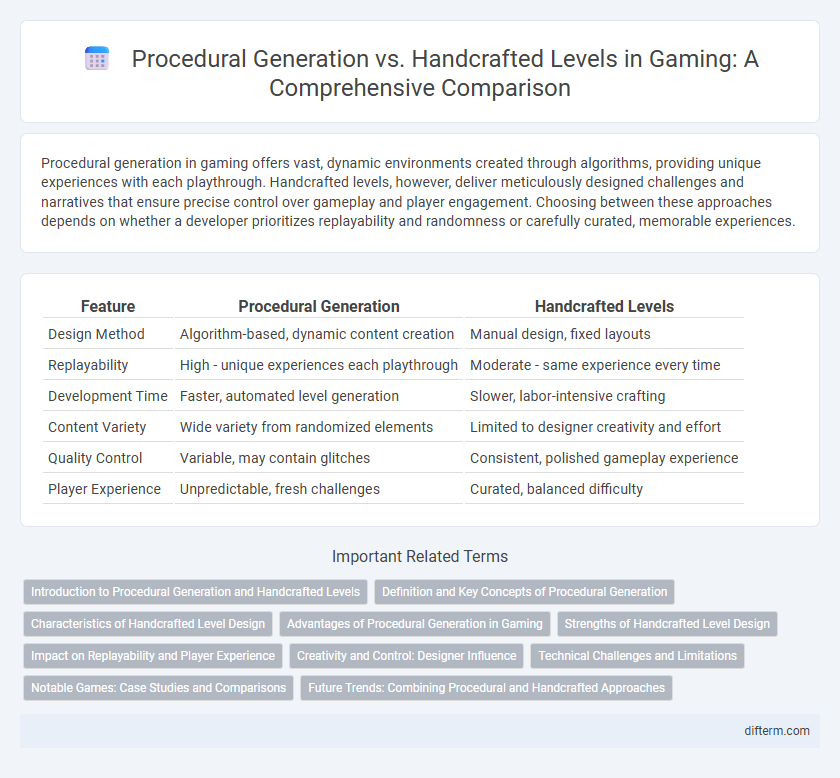Procedural generation in gaming offers vast, dynamic environments created through algorithms, providing unique experiences with each playthrough. Handcrafted levels, however, deliver meticulously designed challenges and narratives that ensure precise control over gameplay and player engagement. Choosing between these approaches depends on whether a developer prioritizes replayability and randomness or carefully curated, memorable experiences.
Table of Comparison
| Feature | Procedural Generation | Handcrafted Levels |
|---|---|---|
| Design Method | Algorithm-based, dynamic content creation | Manual design, fixed layouts |
| Replayability | High - unique experiences each playthrough | Moderate - same experience every time |
| Development Time | Faster, automated level generation | Slower, labor-intensive crafting |
| Content Variety | Wide variety from randomized elements | Limited to designer creativity and effort |
| Quality Control | Variable, may contain glitches | Consistent, polished gameplay experience |
| Player Experience | Unpredictable, fresh challenges | Curated, balanced difficulty |
Introduction to Procedural Generation and Handcrafted Levels
Procedural generation uses algorithms to create game levels dynamically, offering vast variety and replayability while reducing development time. Handcrafted levels are meticulously designed by developers, ensuring precise control over gameplay pacing, narrative elements, and player experience. Combining both methods can yield immersive environments that balance unpredictability with intentional design.
Definition and Key Concepts of Procedural Generation
Procedural generation in gaming refers to the algorithmic creation of content such as levels, maps, or assets, using defined parameters and randomization techniques rather than manual design. This method leverages mathematical functions, noise algorithms, and rule-based systems to produce diverse, unpredictable environments that enhance replayability. In contrast to handcrafted levels, procedural generation enables scalable content creation with dynamic variations, reducing development time and increasing player engagement through unique gameplay experiences.
Characteristics of Handcrafted Level Design
Handcrafted level design emphasizes meticulous attention to detail and deliberate placement of elements, creating a curated and immersive player experience. Designers can control pacing, difficulty, and storytelling through carefully crafted environments that respond to player behavior. This approach often results in unique, memorable levels that highlight artistic vision and narrative depth.
Advantages of Procedural Generation in Gaming
Procedural generation in gaming offers vast advantages such as creating expansive, diverse worlds with minimal manual input, enabling infinite replayability through unique content every session. This method reduces development time and cost by automating level design, allowing developers to focus resources on other aspects like narrative and mechanics. Furthermore, procedural algorithms adapt dynamically to player behavior, providing personalized and evolving gameplay experiences that handcrafted levels cannot easily replicate.
Strengths of Handcrafted Level Design
Handcrafted level design offers precise control over gameplay pacing, story integration, and visual aesthetics, ensuring a curated player experience. Designers can create intricate puzzles, tailored challenges, and memorable environments that procedural generation often struggles to replicate. This approach enhances narrative depth and emotional impact by allowing deliberate placement of key elements and scripted events.
Impact on Replayability and Player Experience
Procedural generation enhances replayability by creating unique, unpredictable levels each playthrough, fostering continuous player engagement through varied challenges and environments. Handcrafted levels provide meticulously designed experiences with deliberate pacing, narrative depth, and balanced difficulty, offering memorable and refined gameplay moments. The choice between procedural and handcrafted design directly influences player experience by balancing novelty and consistency, impacting player retention and satisfaction in gaming.
Creativity and Control: Designer Influence
Procedural generation enables vast and diverse gaming environments by algorithmically creating content, fostering creativity through unpredictable and unique player experiences. Handcrafted levels offer designers precise control over every element, ensuring intentional pacing, storytelling, and artistic detail that shape player engagement. Balancing procedural methods with handcrafted design allows developers to harness both creative spontaneity and meticulous oversight in game world construction.
Technical Challenges and Limitations
Procedural generation faces technical challenges such as maintaining coherent level design, managing performance constraints, and ensuring varied yet balanced gameplay experiences. Handcrafted levels excel in detailed storytelling and precise control but demand significant time and resources from designers. Limitations of procedural methods include unpredictable player experiences and potential for repetitive content, while handcrafted levels struggle with scalability and replayability.
Notable Games: Case Studies and Comparisons
Notable games demonstrate the distinct advantages of procedural generation and handcrafted levels, with titles like "Minecraft" showcasing vast, endlessly explorable worlds through algorithms, while "The Last of Us" exemplifies meticulously designed environments that enhance narrative immersion. Procedural generation enables scalability and replayability in games such as "No Man's Sky," whereas handcrafted levels in "Dark Souls" deliver tightly controlled gameplay experiences with deliberate level design and enemy placement. Comparative case studies reveal how developers balance algorithmic creativity and artistic precision to achieve unique player engagement across genres.
Future Trends: Combining Procedural and Handcrafted Approaches
Future trends in gaming increasingly emphasize hybrid level design, blending procedural generation's scalability and unpredictability with handcrafted levels' intentional detail and narrative depth. By integrating AI-driven algorithms with expert craftsmanship, developers can create expansive worlds that retain unique storytelling elements and player engagement. This approach leverages the strengths of both methods, enhancing replayability and ensuring diverse, immersive experiences tailored to evolving player preferences.
procedural generation vs handcrafted levels Infographic

 difterm.com
difterm.com